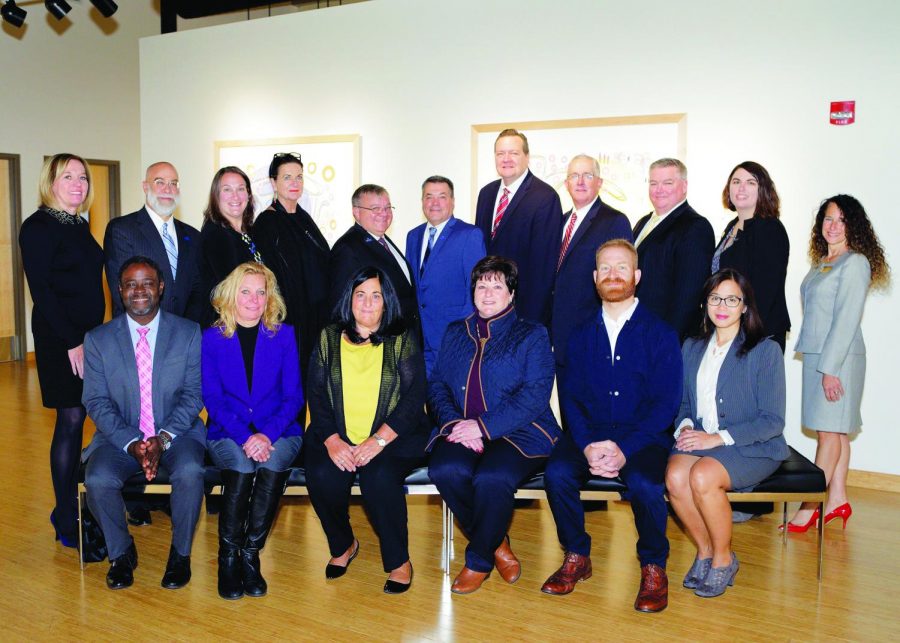University Hosts 10th Annual Healthcare Symposium
The university hosted the 10th annual Healthcare Symposium on Friday, Oct. 18 in collaboration with the art gallery.
The event started in the morning and ran until the afternoon, featuring speakers from different departments and areas of healthcare. Guests were able to visit the Pauly Friedman Art Gallery throughout the day to see the “Arts in Healthcare” exhibit that was planned to help supplement the symposium.
Dr. Amanda Caleb, associate professor of English and director of medical and health humanities, took part in the event as a speaker, introducing Lalaine Little, director of the art gallery, who then introduced Joseph Cohen, one of the artists who contributed to the exhibit. This was Caleb’s second year participating in the symposium.
She said her favorite parts of the day were hearing Cohen and Dr. Joseph Ravenell speak.
“I have to say what Joseph Cohen presented on was extraordinary,” Caleb said. “The development of paint that has sort of hyper, ultraviolet sense to it that can be used to detect bio markers of cancer; I think that’s extraordinary to see what the art world can offer to the medical world, that intersection. I also thought the second speaker in the morning speaking about how you bring healthcare to the community and the use of the barber shop to provide healthcare information, healthcare access, particularly to the African American community. I thought that was just extraordinary to think about how this functions in the world.”
Barbara Schwartz-Bechet, dean of College of Health Sciences and Education, also took part in the event and enjoyed it.
“As the new dean of the College of Health Sciences and Education, it was my first experience with the symposium and I thought it was outstanding,” Schwartz-Bechet said. “The speakers were knowledgeable, portrayed human emotions and personal stories, and engaged the audience.”
Caleb agreed, saying she loved the direct inclusion of the art gallery.
“I think this is so essential to healthcare,” she said. “I think the arts have a lot to offer, not just in terms of the tech in this case, which is sort of extraordinary, but humanizing the healthcare experience and I think that’s an important thing to remember that the artist are expressing their own experiences with healthcare, others experiences, and understanding the emotional impact of good care or bad care.”
Schwartz-Bechet said the inclusion of the art gallery offered another element of understanding for people.
“The art gallery was a dynamic part of the symposium and worked hand in hand with the topics discussed and enabled a deeper understanding of the link between art, health and medicine,” she said.
Caleb believes the symposium is important because it acts as a way to bring the community to campus.
“I think it’s got a little bit of something for everyone. The speakers are always very different,” she said. “I think with that range of different elements and layers of healthcare, all of us can find something useful whether you are a health sciences major or not. We’re all going to interact with the healthcare system and understanding how we interact with it, some of the problems, think it’s an important way to get the community on campus, to interact with our faculty and our students.”
Schwartz-Bechet said its importance lies in the way it educates people.
“The symposium is important not only for our students but for the community and the faculty to broaden their own understandings of the human condition and what we can do in order to live the charisms of the university to help and be part of the greater good of society,” she said.
For next year’s symposium, Caleb would like to see more focus on the issue of the healthcare system.
“Sometimes, if I can be critical a little bit. I don’t think it’s as critical of the system as it could be,” she said. “I think this year it was a little bit, actually, with the second speaker, but it’s something I hope we continue to look at that there are issues in the healthcare system that we really need to address.”
She would also like to see narrative arts involved and a variety in the topics continue to expand.
“I love that we’ve been working with the visual arts,” Caleb said. “I’d love to see us think about the literary arts as well and how writing can be used in terms of therapeutic measures, can be used to enhance empathy in practitioners. I’d love to see that interacted. I hope we look into more health disparity issues. I think that’s a growing problem. It’s always been there, but you’re seeing more and more issues with health disparities. I’d love to see a public health focus one year. Hopefully, it won’t be an issue next year, but vaping has been big in the news. It would be interesting to see the regulation of vaping and some other public health issues as well. I hope they just keep expanding with some of these really great and interesting topics.”

